
|

|
|
Home Site Search Contact Us Subscribe
|
|
What Does Recovery Look Like? The current recovery efforts in Japan following the 2011 earthquake and tsunami draws many parallels to our post-Sandy conditions in the Northeast U.S., and should temper our expectations and help illuminate realities of our road ahead. Do they have the answers we seek? By Illya Azaroff, AIA September 26, 2014 Since Superstorm Sandy, many of us have been engaged in recovery one way or another, as an architect, engineer, community leader, or as a person directly affected by the storm. It has been two years of a seemingly endless stream of work, skill-building, and knowledge-sharing since the storm surge hit the Northeast Region of the United States. Whether engaged in actual buildings, study, or debate, we seem to be wrapped up in the broad and deep issues of climate change and associated learning that accompanies our new reality in the Northeast.
One truth we are faced with is that the tendency for today's culture to move rapidly from one subject to the next, so, too, is our attention span for news. Our collective conscious does not stay focused for long on any one thing. The post-Sandy environment is no different. Many people have already moved on to the next "big thing," noting that our problems have been solved with the billions of federal dollars pumped into the region. So we are going to be fine. However, if you are living through the recovery process as a displaced person or business owner left wondering when the neighborhood will bounce back, your perspective is plainly different. In this case, you may be of the mind to ask: Why is recovery taking so long? Are we done with rebuilding yet? How long is this going to take? Another six months? A year? Come on, let's wrap this thing and move on ... where's my bagel? I'll have that light and sweet...taxi!
But that's the thing. We have not heard in a clear concise manner the answer to two very important questions: 1) What does recovery look like? 2) How long will the recovery process take? Answer these, and the truth will set in motion certain freedoms for everyone.
To get at these questions, I recently went to Japan to take a look at the recovery efforts from the March 11, 2011, when the Great Tohoku Earthquake and subsequent tsunami claimed more than 18,000 lives and devastated coastal areas throughout northeastern Japan. Surely the most prepared country in the world with the third largest economy draws many parallels to our conditions in the Northeastern U.S. Do they have the answers we seek?
As of March 2014, three full years after the tsunami, 270,000 people across the region are still displaced, living in temporary housing. That is down from 370,000 people who were initially displaced. New coastal defenses and infrastructure, such as sea walls, are under construction, but clearly far from completion. Debris from the tsunami is still evident in many places. In port cities such as in Ishinomaki (pop. 160,000), the economy has not recovered as businesses struggle to find customers and viable space, where once vibrant neighborhoods existed.
Sound familiar? Does this resonate with parts of Brooklyn and Queens? Is the economic struggle similar to the New Jersey Shore? Well – yes, it does. But do the Japanese have answers that can help forecast our recovery timeline?
Sendai City
On my tour I had the pleasure of visiting with Sendai City Government officials, who welcomed me with open arms and open minds. Sendai City Planning, Recovery Operations, Temporary Housing Unit, and the Office of the Mayor gave me an entire day of their valuable time to review the damage to the city and surrounding region. I was given presentations on long-term planning, and toured temporary and newly-constructed housing, where I talked with the people living there. Sendai is a city of 1.1 million people and lies on the coastal zone hit hard by the tsunami. Thousands of buildings were washed away, many of which were very robust, reinforced-concrete structures built to withstand earthquakes. As a result of the tsunami the city government has rezoned the affected areas as non-residential coastal zones; if you own land and want to rebuild there, you simply cannot. The decision was to not rebuild in these areas of known risk, and relocate all former residents to new housing and constructed neighborhoods within Sendai City. In essence, up-zoning and increased density in the city is the plan for recovery and resilience.
When asked about the strategy, city officials reinforced that life safety, even a single life, trumps tradition, and that the public good is protected by not living in high-risk zones. Layers of new infrastructure and coastal protection are being built in these zones to further protect Sendai City itself, which will also provide public amenities, such as parks, transit systems, farm land, etc. The plan considers the next 100 years and beyond for Sendai and the surrounding towns.
Could and should the Northeastern U.S. do the same? Move tens of thousands, if not hundreds of thousands, of residents off of the barrier islands, out of known areas of risk? For better or worse? With politics as they are, not likely.
Infrastructure projects, such as 40- to 60-foot-high sea walls, lifting of entire communities, and relocation of entire neighborhoods and towns are in full swing. There is no fear of shaping the landscape at large scales to achieve their goals, such as taking down entire mountains to raise entire towns through cut-and-fill.
Large-scale reshaping of the landscape is evident everywhere you look. Are we in for similar circumstances, or do we have the stomach for such moves? To date, very little large-scale coastal protection has been put in motion in the Northeast U.S. Plans by Rebuild by Design and the Army Corp of Engineers are encouraging, but far from a final design solution – and even further from implementation. What we do see is sand replenishment, constructed dunes and berms, rip-rap, and similar beach protection that could not withstand a Sandy-like event on their own.
But, even with Japan’s robust building effort, expectation and reality rub up against one another. Residents who live in the coastal communities being reshaped by large infrastructure projects rely on the sea as a primary revenue generator, and their fundamental relationship with the sea is integral to their lives. Giant sea walls change that relationship in a way that most cannot accept. The fight over sea walls is in full swing – they are not simply taking away the view – they are changing how one can access the water.
Learning from recovery
Among the many areas where we can learn a great deal from the great eastern earthquake is the Japanese method of evacuation and relocation. All displaced families registered to live in temporary housing near former neighbors to help maintain community ties. In fact, everywhere I travelled the idea of community and well-being that stems from knowing your neighbor was central to preparation, mitigation, and recovery. These are not simply displaced people or families; these are displaced communities that will stay together at all cost. New housing projects I visited confirmed that "community" remained the governing factor to resilience-planning all the way through to resettlement. When interviewed, residents in both temporary and new housing alike were happy and smiling about their circumstances, noting that they are alive and well, and, more importantly, among friends and neighbors.
Simply put, the answer to the question "What does recovery look like," from the Japanese perspective, is the point when "community" is maintained or re-established. Is that what recovery looks like for New York and New Jersey? Or does our recovery hinge on jobs, restarting the economic engine, and revenue generation? In a recent presentation at the Center for Architecture in Manhattan, I asked Dan Zarrilli, director of the New York City Office of Recovery and Resilience, the same question, and his response was tied to economy and jobs. Not a bad answer, but it reveals a different approach to recovery and our current problems.
Now to the question: How long does recovery take? It depends on how you characterize “recovery.” If it is defined as community or economy, then we may have a difficult task ahead. If we take on only the physical state of recovery – buildings, infrastructure, and associated networks – as our measure, then we can plan a timeline tied to goals set forth. How long will any of the Rebuild by Design projects take, soup to nuts?
In Japan, the timeline was clear and often stated in the news and media by officials who project another eight to nine years to complete the region’s plans. That is a total of 12 years to execute comprehensive rebuilding of coastal protection measures, major infrastructure, and resettlement. Again, this is a country of means, better prepared for disaster and recovery, with fewer political boundaries and entanglements. In fact, the officials, engineers, and architects doing the work all echo the desire to move rapidly, as many of the displaced are part of Japan’s growing ageing population. To a person, they do not want anyone’s last days to be in temporary housing – a point stressed again and again by everyone with whom I spoke.
The correlation to New York and New Jersey is no different, and we need to hear from our public officials that recovery of this type will take a decade at least. That bitter pill needs to be administered and swallowed because public expectations do not match physical reality. It is far better that communities and people who are waiting know the timeline and future risks, which will enable them to make the decision to either establish a new life somewhere else or wait it out.
One final point in need of a dose of reality is the cost of rebuilding. It will take hundreds of billions, if not trillions, of dollars to rebuild and make the Northeast Corridor resilient. A realistic price tag for the region is well beyond the federal dollars flowing slowly into these necessary efforts. But that is another story for another day.
We are not alone
The takeaway from my visit to Japan is the sense that everyone I met with is open to collaboration and information sharing. There is a hunger to know what we are doing here in the U.S., post-Sandy, and they recognize we can learn a great deal from one another. I believe that we share the same sentiment here in the Northeast. The world is collectively recognizing that we share a common future in dealing with climate change and defining resilience. I look forward to returning to Japan with an open mind and a desire to learn from our colleagues. And I look forward to a clearer path forward from our own leaders.
Illya Azaroff, AIA, is the founder of +LAB architect, PLLC in Brooklyn, NY, and an associate professor at New York City College of Technology (CUNY), where he shares his expertise in disaster mitigation and resilient building strategies. He is founding co-chair of AIA New York Chapter’s Design for Risk and Reconstruction Committee (DfRR), and was among the leaders of the AIANY Post-Sandy Initiative and a contributor to the Post-Sandy Initiative Report. The report received the 2014 AIA National Collaborative Achievement Award; Azaroff also received the 2014 AIA National Young Architects Award. He is a trained instructor with the NDTPC-National Disaster Training Preparedness Center in Hawaii, and trained in post disaster damage assessment (SAP) by Cal EMA. His work with the AIA Regional Working Group, which incorporates experts from four regional states, garnered Azaroff the 2014 AIANYS Presidential Citation. His research in Japan and other recent disaster sites around the world have been supported by a CUNY research grant. He serves on the AIA New York State board as New York Regional Director for the Young Architects Forum (YAF), and on the AIA New York Chapter board. |
(click on pictures to enlarge)  Nishiko Artist Nishiko’s visualization of the height of waves from the 2011 tsunami in Japan. Seawalls are being proposed across the region to meet these heights (up to approximately 65 feet). 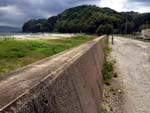 Illya Azaroff A typical current sea wall.  Illya Azaroff Azaroff standing in front of a mock-up of proposed sea wall height. 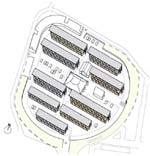 Shigeru Ban Architects Plan of Shigeru Ban’s three-story temporary housing in Onagawa, Japan. 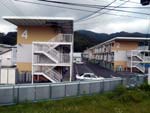 Illya Azaroff Shigeru Ban’s temporary housing in Onagawa started construction on July 22, 2011, and was completed on November 4, 2011. 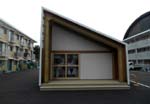 Illya Azaroff Community center for Shigeru Ban’s temporary housing, Onagawa. 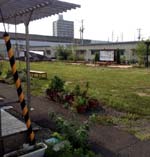 Illya Azaroff Sendai City temporary housing: Personal gardens, community spaces, and central square are part of the programmatic elements in these communities. 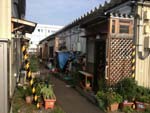 Illya Azaroff Entryway adaptations to the temporary housing in Sendai City. 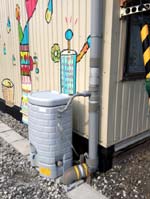 Illya Azaroff Rain-water harvest adaptation for the temporary housing, Sendai City.  Illya Azaroff Artwork adorns temporary housing units, Sendai City. 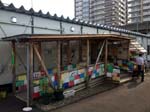 Illya Azaroff Relocated indoor community space personalized with artwork by the children of the temporary housing community, Sendai City. 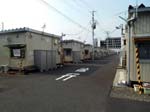 Illya Azaroff Sendai City’s temporary housing, three years after the tsunami. Throughout the region 270,000 people are still displaced and living in housing such as this. 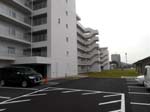 Illya Azaroff New, multi-family replacement housing, Sendai City. Entire displaced communities were relocated together to keep a sense of neighborhood. 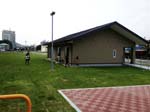 Illya Azaroff Community centers and playing fields are regular programmatic elements in new Sendai City housing. 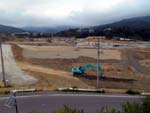 Illya Azaroff Moving of 6-7 million cubic meters of earth for infill in Onagawa.  Marsha-Ann Cadougan/Illya Azaroff Cut-and-fill process moving 6-7 million cubic meters of earth, Onagawa.  Marsha-Ann Cadougan/pluslab Architects Existing roadway with proposed final height of Onagawa using 4-4.5-meter infill.  Marsha-Ann Cadougan/pluslab Architects Dashed line indicates proposed height of infill for new Onagawa. 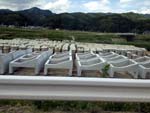 Illya Azaroff Layers of coastal protection to be deployed in Ishinomaki, Japan. 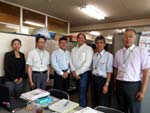 Illya Azaroff Sendai City Government meeting Illya Azaroff (center): l-r: Wataru Murakami, Manager, Sendai City Urban Planning Bureau; Masato Hasegawa Technical officer, Sendai City Urban Planning Bureau; Hitoshi Ichinohe, Seiichi Takahashi, Hiroshi Kyouya, Sendai City Urban Planning Bureau, Takeno Suzuki, Coordinator for International Relations, Miyagi Prefectural Government (translator). 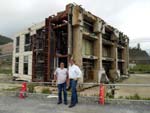 Illya Azaroff Illya Azaroff (right) with Onagawa engineer Takuro Kurushima, Construction Technology Institute (CTI) Engineering Co., Ltd., and former Director of Onagawa Reconstruction Office. They are standing in front of one of the remaining overturned structures that will be made into memorials to the devistation. |
© 2014 ArchNewsNow.com